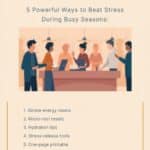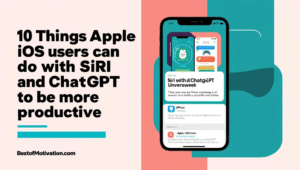Quick Summary: Retail worker burnout spikes during busy seasons due to long shifts, emotional labour, unpredictable rotas, and constant customer pressure. This guide gives you five realistic energy resets, a 7-day recovery plan, and simple habits you can use before, during, and after shifts to protect your mental and physical wellbeing.
Long shifts. Endless queues. Rude customers. Last-minute rota changes. Pressure to smile, be “on”, and hit targets even when you’re running on fumes.
Retail worker burnout is rising fast, especially during intense holiday periods when pressure is highest.
Related: How to Improve Leadership Skills
Need a fast fix? Jump straight to the RESET framework below.

If you’re exhausted, snapping at small things, or dreading your next shift, it’s not because you’re weak. It’s because your body and mind are under constant pressure. That’s retail worker burnout — and you deserve tools to protect your energy, even when you can’t control the rota.
This is your busy-season survival guide. No fake “just say no to shifts” advice. Just real, doable resets you can use between shifts, on breaks, and on your days off to ease retail burnout and shift-work fatigue.
Why Retail Worker Burnout Is Real (And More Common Than You Think)
Understanding retail worker burnout starts with recognizing the constant emotional and physical strain that builds up during peak seasons.
Peak season in retail and shift work is intense:
- Overtime and back-to-back shifts
- Crowded stores, messy aisles, constant noise
- Angry customers taking their stress out on you
- Managers under pressure, passing that stress down
You’re expected to stay polite, patient, and productive — even when your brain is screaming for a break.
You’re not imagining it:
• A major workforce study found that stress and burnout rose for 82% of retail workers — higher than workers in most other industries. (Retail Gazette)
• During peak seasons like Christmas, health & safety bodies warn that long hours, irregular shifts, and crowded store conditions significantly increase fatigue and burnout. (HSE UK)
• In the UK, over 50% of retail workers say the rising cost of living is damaging their mental health. (CIPD Research)
• Younger retail staff are hit hardest — around 1 in 3 workers in their 20s and early 30s needed time off due to stress or poor mental health. (Mind UK)
These numbers show how widespread retail worker burnout has become across supermarkets, fashion stores, and convenience retail.
Burnout is not a personal failure.
It’s often a system problem: understaffed stores, constant customer pressure, and rotas that don’t give your body time to reset.
Why Busy Seasons Hit Retail & Shift Workers So Hard
Irregular Shifts and Zero Recovery Time
Rotating shifts, late closes, and early starts mess with your body clock. You never fully catch up.
When your sleep is all over the place, you’re more likely to:
- Feel chronic fatigue and heavy tiredness
- Struggle with brain fog, irritability, and low mood
- Make more mistakes or have near-misses and accidents
Health organisations warn that poorly designed shifts and long hours build fatigue, which directly impacts performance, mental health, and safety — especially in jobs like retail and night work.
Emotional Labour and Difficult Customers
Emotional labour is the invisible work of staying calm, friendly, and professional — even when people are rude, demanding, or entitled.

In peak retail season, that ramps up:
- Shoppers in a rush
- Last-minute demands
- Complaints about queues, stock, and prices (that you don’t control)
Holding it together all day burns emotional energy faster than walking 15,000 steps. Over weeks, that emotional drain can turn into full-on retail worker burnout.
Money Stress and Cost of Living Pressure
Financial pressure doesn’t just drain your patience — it accelerates retail worker burnout by keeping you in constant tension.
For many retail and shift workers, saying “no” to extra shifts doesn’t feel like an option.
You might:
- Rely on overtime just to pay rent and bills
- Feel guilty turning down shifts you actually need to rest
- Live with constant background fear about money
Recent research in the UK found that over half of retail workers say the rising cost of living is impacting their mental health, with many struggling to meet monthly outgoings.
So you keep pushing — even when your body is asking you to slow down.
The Hidden Mental Health Toll of Shift Work
When these symptoms pile up, retail worker burnout often shows up as emotional numbness or a complete lack of motivation.
Shift work isn’t just about tired feet. It’s linked to:
- Higher risks of anxiety and low mood
- Feeling “out of sync” with friends and family
- Long-term health issues if fatigue never gets a chance to reset
If you’ve been feeling unlike yourself — more numb, more on edge, more detached — you’re not broken. You’re reacting to chronic stress and shift-work fatigue.
You can’t fix your rota overnight or magically double your pay.
But you can build an energy plan that stops busy season from breaking you.
For a bigger-picture view of why retail feels so intense right now — and what’s coming next — explore Leading Retail in the UK: Challenges, AI Disruption, and Building Future Leaders. It connects today’s burnout pressures with the future skills retail teams actually need.
The Energy Reset Framework for Retail & Shift Workers
RESET is a simple way to break the cycle of retail worker burnout without needing weeks off or huge lifestyle changes.
Meet RESET — simple, realistic retail burnout tips you can actually use, even in chaotic weeks:
RESET = Rest • Refuel • Release • Routines • Reach Out
You don’t have to do all of it perfectly. Small, consistent shifts are enough to start protecting your energy from retail worker burnout.
1. Rest: Micro-Rest, Not Perfect Sleep
During peak season, perfect sleep is… not happening. Let’s aim for “better, not perfect.”

Pick 2–3 simple rules:
- Protect one non-negotiable sleep window
Choose a minimum 4–5 hour block you fiercely protect, even if the rest of your sleep is messy. - Make your room as dark and quiet as possible
Use an eye mask, curtains, or even a hoodie over your eyes. Put your phone out of arm’s reach. - No doomscrolling in bed
Tell yourself: “Phone down when I lie down.” Even 10 minutes less scrolling helps your brain switch off.
Micro-Rest Ideas Between Shifts
- 5–10 minute “power down” before bed: dim lights, slow breathing, no screens
- Short nap (20–30 minutes) if you have a long gap between shifts
- Put your feet up against a wall for 3–5 minutes to calm your nervous system
For a deeper dive into smarter rest, link this with Sleepmaxxing: The Viral Trend That’s Redefining Rest in 2025.
2. Refuel: Simple Food & Hydration Wins
You don’t need a perfect meal plan. You need basic fuel that keeps you going.
Focus on:
- Hydration first
Keep a refillable bottle with you. Aim to finish it 2–3 times per shift. - Cheap, steady-energy snacks
- Nuts or trail mix
- Bananas or apples
- Simple sandwiches or wraps
- Yogurt or boiled eggs if you can store them safely
- Avoid running on just energy drinks + sugar
They give you a spike, then a crash — which just makes shift-work fatigue worse.
3. Release: Quick Stress Off-Ramps
Stress gets stored in your body. If you never release it, it builds into full retail worker burnout.
Try 3–5 of these quick “off-ramps”:
- 60-second breathing reset in the stockroom
Inhale for 4, hold for 4, exhale for 6. Repeat for a minute. - 5-minute walk outside after your shift
No music, no scrolling. Just moving and letting your brain process. - 2-minute stretch routine
Roll your shoulders, stretch your neck, open your chest, stretch calves and lower back. - One-line journaling
Ask: “What drained me today? What helped?” Write one sentence. That’s it.
Releasing tension regularly is what stops it from turning into full-on burnout.
4. Routines: Pre-Shift and Post-Shift Rituals
Tiny rituals create a sense of control in a job that often feels chaotic.
Pre-Shift Ritual Ideas
- Check in: “How’s my energy from 1–10?”
- Set one simple intention:
- “I will take my break.”
- “I will breathe before reacting.”
- “I will speak kindly to myself.”
- Fill your water bottle + pack at least one snack.
Post-Shift Ritual Ideas
- Drink water and have a small snack to avoid crashing
- 5–10 minutes with no screens when you get home
- One small self-care move: hot shower, music you love, gentle stretching, or a quick journal brain dump
You can link this to 5 Sunday Reset Routine Ideas for Life Balance & Well-Being and The 1-Hour Rule for Productivity: Fast-Track Your Goals Without Burning Out — but in micro form for shift workers.
5. Reach Out: Support & Boundaries
You can’t carry all of this alone. Reaching out is a strength move, not a weakness.

With co-workers
- “I’m knackered this week. Can we check in on each other during the shift?”
- “If you see me forgetting to take my break, nudge me?”
With friends & family
- “I can’t go out tonight. I need to rest after this week.”
- “December is intense for me at work. Can we plan something low-key on my day off?”
With managers (where possible)
- “Is there any way to move one of my shifts so I can get a proper recovery day?”
- “I’m feeling the workload a lot right now. Are there any small tweaks we can make?”
You deserve to ask for small adjustments that protect your health.
Quick Support Boost (Optional)
Want help turning this into a simple one-pager you can stick on your fridge or locker?
Download your Busy Season Energy Plan – 1-Page PDF for Retail & Shift Workers and personalize your:
- Sleep window
- Hydration target
- Pre-shift ritual
- Post-shift ritual
- Go-to stress release ideas
Use it as your personal busy season retail survival guide.
A 7-Day Energy Reset Plan for Busy Retail Weeks
Use this 7-day plan whenever the rota gets wild. It links perfectly with your 7-Day Realign Challenge and helps shift workers avoid burnout in retail without needing weeks off.
Day 1–2: Protect Your Sleep Window 😴
- Choose a realistic sleep window (even 4–6 hours) and commit to it.
- Do one thing to improve your sleep space: darker room, less noise, cooler temperature, no phone in bed.
- Optional: take your Happiness Compass Assessment to check where your overall wellbeing is right now.
Day 3–4: Fix One Major Energy Leak 🔌
Pick one big energy leak that hits you hardest:
- Doomscrolling late at night
- Drinking alcohol most evenings
- Skipping meals
- Saying yes to every extra shift
Your challenge: reduce or pause that one leak for two days.
If alcohol is a big drain, point yourself towards The 30-Day No-Alcohol Challenge: Boost Your Energy & Clarity as a deeper next step.
Day 5–6: Build a Pre-Shift and Post-Shift Ritual 🔁
Lock in two simple rituals:
- Pre-shift:
- One intention (e.g., “I will take my break.”)
- A few deep breaths before walking onto the shop floor
- Fill water bottle + grab your snacks
- Post-shift:
- Hydrate and eat something light
- 10 minutes off screens to let your brain land
- One calming activity: shower, music, stretching, journaling
Once a week, use your 1-Hour Rule just for you — rest, planning, or something that fills you up (not chores).
Day 7: Reset & Reflect 🧠
Take 10–15 minutes to reflect:
Ask yourself:
- “When did I feel most drained this week?”
- “What helped me feel even 10% more human?”
- “Where do I want to protect a boundary next week?”
- “Is this workload sustainable for me long term?”
Next step:
When you’re ready for a deeper reboot, join the 7-Day Realign Challenge to gently reset your body, mind, and goals once the rush slows down.
Real Examples: Energy Reset in Real Life
Real stories often make it easier to understand how retail worker burnout appears in everyday work life.
Example 1 – Sam, 24, supermarket cashier
Sam was doing back-to-back late shifts, then staying up gaming until 3 a.m. He started by protecting a 5-hour sleep window and bringing a big water bottle plus a banana to every shift. Within two weeks, he felt less snappy with customers and stopped needing three energy drinks a day.
Example 2 – Aisha, 32, fashion retail assistant
Aisha dreaded December every year. This time, she created a 3-step pre-shift ritual: breathe, intention, water. She also added a 5-minute post-shift walk before checking her phone. She still felt tired — but not broken. She used her next break in January to start the 7-Day Realign Challenge and realised she wanted to move into a higher-paid supervisor role.
Example 3 – Jake, 29, warehouse night shift worker
Jake was drinking most nights just to “switch off.” He tried a mini no-alcohol reset for 7 days and replaced his usual drink with a hot tea and music session. His sleep got deeper, his mood improved, and he decided to commit to the 30-Day No-Alcohol Challenge.
Common Mistakes to Avoid
When you’re exhausted, it’s easy to slide into habits that quietly make retail worker stress worse. Watch out for:
- Thinking you have to “earn” rest
You don’t need to hit a certain number of hours or steps to deserve sleep or downtime. - Living on caffeine and sugar
Coffee and energy drinks can be tools, but they’re not a strategy. If they replace food and water, you’ll crash harder. - Skipping every break “to be helpful”
Breaks are part of your job, not a luxury. Skipping them just drains you faster and increases mistakes. - Saying yes to every extra shift automatically
It’s okay to pause and ask: “Does my body have capacity for this?” - Ignoring early warning signs
Constant irritability, headaches, dread, or numbness are all signals — not something to power through forever.
When Burnout Is a Red Flag — Not Just “A Busy Week”
Busy weeks happen. But sometimes it’s more than that.

Watch out for these red-flag signs of serious retail worker burnout:
- Feeling empty, numb, or detached most of the time
- Constant dread before every single shift
- Frequent headaches, stomach issues, or getting ill again and again
- Panic attacks, crying at work, or feeling hopeless
- Struggling to care about anything — customers, targets, even yourself
If you recognise several of these, it’s time to take it seriously.
What to do next:
- Speak to your GP or a health professional as soon as you can
- Ask if your workplace has an Employee Assistance Programme (EAP) or mental health support
- Talk honestly with someone you trust about how bad it feels right now
If you never get real recovery time between peak periods, that’s a sign the problem isn’t just you — the role, rota, or environment may not be sustainable. It might be time to explore different roles, a new store, or even a new path.
Here are the most common questions people ask when they’re dealing with retail worker burnout during peak season.
FAQs: Retail Worker Burnout in Busy Seasons
1.How do I know if it’s retail worker burnout or just “normal tiredness”?
Normal tiredness improves after a good night’s sleep or a day off.
Retail worker burnout sticks around for weeks — even when you rest.
If you’re feeling numb, constantly irritable, dreading every shift, or noticing physical symptoms like headaches and upset stomach, that’s closer to burnout than simple fatigue.
2.Can I recover from retail worker burnout while staying in the same job?
Yes — in many cases.
Start with micro-rest, simple routines, better hydration, small boundaries, and talking openly with someone you trust.
But if nothing changes after a few weeks (or your rota stays chaotic), it might be time to explore a different department, store, or role.
3.What if I can’t afford to say no to shifts?
Start with boundaries that don’t affect your income:
Protect a sleep window
Take every break you’re entitled to
Drink water consistently
Bring snacks to avoid crashes
Use fast stress-release resets after each shift
These small steps won’t fix everything, but they stop burnout from escalating while you plan your next move.
4.How can I recover from burnout while still working full-time in retail?
Focus on the 3 fastest levers:
• Sleep: Protect one 4–5 hour block
• Fuel: Hydrate and eat small energy-steady foods during shifts
• Rituals: Create simple pre- and post-shift routines
These practices help regulate your nervous system and reduce stress even when your schedule is chaotic.
5.What can managers do to reduce burnout during peak retail season?
Good managers can make a huge difference.
They can:
Give predictable breaks
Balance the rota so the same people aren’t always closing
Check in with staff and adjust workloads
Step in during customer escalations
Allow staff to swap shifts when needed
Even small changes help protect their team’s energy.
6.When should I consider leaving my retail job because of burnout?
If you feel constant dread, hopelessness, or physical symptoms that don’t improve — even when you rest — it’s a sign something deeper is wrong.
If your store is always understaffed, you never get recovery time, or your concerns are ignored, it might be time to explore new roles, a different store, or a new career path.
7.What’s the fastest way to feel better after a brutal shift?
Use a quick 3-step reset:
• Hydrate + eat something light
• Move your body for 3–5 minutes (walk outside, stretch, breathe)
• Do a “brain dump” to clear the stress from your system and let your mind settle after a tough shift
These tiny resets help your body switch out of “survival mode” much faster.
Turn This Into Action: Protect Your Energy, Then Plan Your Next Move
You are not just a name badge and a rota.
You’re a human being with a nervous system, dreams, and a future.
Here’s how to turn this article into action:
- Protect your energy this season
- Use the RESET framework (Rest, Refuel, Release, Routines, Reach Out).
- Try the 7-Day Energy Reset Plan on your next intense week.
- Download the Busy Season Energy Plan PDF and stick it somewhere visible.
- Give yourself a proper reset
- When peak season ends (or the rota eases), join the 7-Day Realign Challenge.
- Treat it as your week-long reset to reconnect with your body, mind, and goals.
- Plan what’s next for your career and life
- If your current job feels unsustainable, use your Life Clarity Toolkit to rethink your direction.
- If you want to climb, earn more, or move into more stable roles, explore the Career Glow-Up Toolkit to map your next move.
You deserve energy, health, and a future that doesn’t burn you out — in retail or beyond.

Final Thoughts
Peak season will always be intense. But feeling destroyed by it doesn’t have to be your “normal.”
Small resets — a protected sleep window, a water bottle, a 5-minute walk, a single honest conversation — can be the difference between barely surviving and actually coping.
You’re not a robot. You’re allowed to rest, reset, and choose a future that looks after you as much as you look after everyone else.
If this guide helped you feel even a little more in control, explore more simple, practical tools inside our Personal Growth section — packed with realistic strategies to boost your energy, clarity, and confidence every day.
👉 Continue with the Personal Growth Collection












